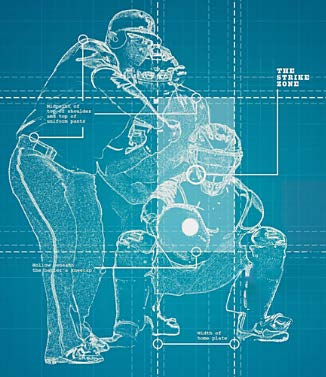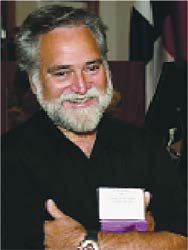ANCORA IMPARO
RICK RADER, MD ■ EDITOR-IN-CHIEF

DISCOMFORT ZONE: "I yearned for the stick ball days when you could declare a "doover" if Mr. Goldstein moved his Plymouth (third base) in the middle of an inning... I was doomed. I prayed for rain.
Strike Zone
The readers of Exceptional Parent Magazine are used to catching fast balls that are thrown "somewhere there."
I thought I got away with murder.
When I was about seven years old, I gave in to peer pressure and joined the Little League. I had aspirations of becoming a polo player, but my parents said their Oldsmobile was not going to stay outside so that I could keep a horse in the garage. So, baseball it was.
Baseball was not my thing. I was getting all I needed in the run, throw and hit culture by playing stickball. We didn't use gloves, we used a pink rubber ball instead of a hard ball, and we used broom sticks with tape on the handle instead of bats. The parked cars and the round iron sewer cov ers were used to demarcate boundaries. It checked off all the boxes.
I went along with my close friends to the Little League, each of us with a bulging back pocket of Topps baseball cards and a pink rubber band.
Tryouts were grueling. We had to run the bases, play the outfield, take batting practice, duck from badly thrown balls, and demonstrate how to slide into bases. This was starting to feel like root canal, or at least what I had heard about getting root canal treatment from a dentist. When the coach said he thought I would be best as the catcher, I thought I got away with murder.
Being a catcher appealed to me. For one thing, you didn't have to run back and forth to the outfield and you were saved from all eyes being on you as you prayed that the fly ball to right field would land in your leather glove. You didn't have to be in the infield where skills, agility and hustle really counted. For me, being the catcher appeared to be nirvana. You got to stay behind home plate, wore almost the same gear as the bomb squad and, from time to time, got to run up to the pitcher to ask him if he had any spare chewing gum. At times, there also was the adrenalin surge when a runner from third was approaching home plate and there was a desperate attempt to get the ball to the catcher for a tag out. But you conducted yourself in virtual anominity. Boy was I wrong!
My illusions were shattered when the coach instructed me to "move your glove to the spot before the ball gets there." It was all downhill after that. The coaching tips seemed more like training for a ninja warrior. "Keep your hands soft, but your arm and wrist firm."
"Don't reach for the ball, let it come to you." "It is easier to reach up for a high pitch than down for a low pitch." "Use your glove to signal the pitcher where the strike should be." I yearned for the stick ball days when you could declare a "do-over" if Mr. Goldstein moved his Plymouth (third base) in the middle of an inning. The catcher's world is the strike zone.
According to Major League Official Rules, "the strike zone is a volume of space delimited by vertical planes extending up from the pentagonal boundaries of the home plate and limited at the top and bottom by upper and lower horizontal planes passing through the horizontal lines of the definition above. This volume thus takes the form of a vertical right pentagonal prism located above home plate. A pitch passing outside the front of the defined volume of the strike zone but curving so as to enter this volume farther back (without being hit) is described as a "back-door-strike."
I was doomed. I prayed for rain. I can't image what being a major league catcher must be like. They are described as being the "quarterback of the baseball team." The majority of major league managers were former catchers. Then there is the full inventory of how balls are delivered to home plate. There is the fast ball, the curve ball, the knuckleball, and the screwball. When asked about the best way to catch a knuckleball, one catcher responded, "Wait 'ill it stops rolling, then go pick it up." It has been said that a batter (and catcher) can see the stiches on a base ball at 80 mph. At 100 mph, that same ball looks like a golf ball. There are pitchers who can throw the ball at 105 mph.
Yogi Berra, everyone's favorite baseball catcher (who said, "I never said most of the things I said"), summed up playing catcher perfectly, "It's 90% mental and the other half is physical." The same could be said about parenting a child with special health care needs, or being a Direct Support Professional, or a therapist, or healthcare provider, or advocate. These professionals and parents often have to play the part of BOTH the pitcher and the catcher. The special needs "strike zone" can change from day to day, from administration to administration. Their "strike zone" is more like the strike zone in stick ball than in baseball. In baseball, the strike zone is concrete, stationary, and well defined. In stick ball the strike zone may depend on where home plate is, perhaps it's a manhole cover, an outline drawn in chalk, three school books on the ground, or simply "somewhere there." The readers of Exceptional Parent Magazine are used to catching fast balls that are thrown "somewhere there." I was the catcher for the Flatbush Flyers for one season. •

ANCORA IMPARO
In his 87th year, the artist Michelangelo (1475 -1564) is believed to have said "Ancora imparo" (I am still learning). Hence, the name for my monthly observations and comments. – Rick Rader, MD, Editor-in-Chief, EP Magazine Director, Morton J. Kent Habilitation Center Orange Grove Center, Chattanooga, TN